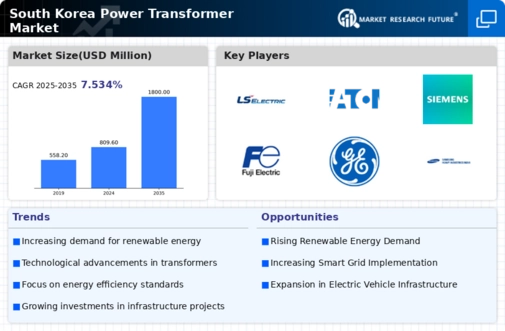Rising Demand for Renewable Energy
The increasing emphasis on renewable energy sources in South Korea is driving the power transformer market. As the nation aims to reduce its carbon footprint, investments in solar and wind energy projects are surging. This shift necessitates the deployment of advanced power transformers to manage the integration of these renewable sources into the grid. In 2025, the renewable energy sector is projected to account for approximately 20% of the total energy mix, thereby creating a substantial demand for efficient power transformers. The power transformer market must adapt to these changes by developing transformers that can handle variable loads and ensure grid stability.
Urbanization and Population Growth
Rapid urbanization and population growth in South Korea are contributing to the rising demand for electricity, thereby impacting the power transformer market. As cities expand, the need for robust electrical infrastructure becomes paramount. The urban population is projected to reach 85% by 2025, leading to increased electricity consumption. This surge necessitates the installation of additional power transformers to support the growing demand. The power transformer market must respond by providing transformers that can efficiently manage higher loads and ensure reliability in densely populated areas.
Government Initiatives and Policies
Government policies aimed at enhancing energy infrastructure are significantly influencing the power transformer market. South Korea's commitment to modernizing its electrical grid through initiatives such as the Green New Deal is expected to bolster investments in power transformers. The government has allocated approximately $10 billion for infrastructure upgrades, which includes the installation of high-capacity transformers. These initiatives not only aim to improve energy efficiency but also to ensure reliable power supply across urban and rural areas. Consequently, the power transformer market is likely to experience growth as manufacturers align their products with these governmental objectives.
Increased Investment in Smart Grid Technologies
The transition towards smart grid technologies is a key driver for the power transformer market. South Korea is investing heavily in smart grid infrastructure to enhance energy management and distribution. This investment is expected to reach approximately $5 billion by 2025, focusing on integrating advanced power transformers that can communicate with the grid. The power transformer market is poised to benefit from this trend, as smart transformers are essential for optimizing energy flow and improving grid resilience. The integration of these technologies is likely to lead to more efficient energy consumption and reduced operational costs.
Technological Innovations in Transformer Design
Innovations in transformer design and materials are reshaping the power transformer market. The introduction of smart transformers, which incorporate digital technology for monitoring and control, is gaining traction in South Korea. These advanced transformers enhance operational efficiency and reduce maintenance costs. The market is witnessing a shift towards transformers that utilize eco-friendly materials and advanced cooling systems, which can improve performance and longevity. As these technologies become more prevalent, the power transformer market is likely to expand, driven by the need for more efficient and sustainable solutions.

















Leave a Comment